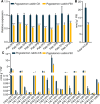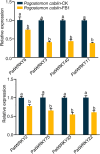Ceramides play a significant role in the response of Pogostemon cablin to bacterial wilt by regulating the ABA pathway
- PMID: 40713504
- PMCID: PMC12297825
- DOI: 10.1186/s12870-025-07009-4
Ceramides play a significant role in the response of Pogostemon cablin to bacterial wilt by regulating the ABA pathway
Abstract
As a strategic resource for both medicine and essential oil, the healthy development of the Pogostemon cablin industry is crucial for the traditional medicine and fragrance sectors. Bacterial wilt represents one of the most significant threats to patchouli cultivation; however, the molecular mechanisms underlying P. cablin's response to bacterial wilt remain unexplored. Here, we conducted transcriptome and metabolome analyses, revealing an increase in the expression of genes associated with lipid pathways and a corresponding rise in the concentration of lipid metabolites in P. cablin following infection by the bacterial wilt pathogen SY1. Further lipidomics analysis demonstrated a significant upregulation of ceramide levels due to SY1 infection. Additionally, hormone analysis indicated that SY1 significantly induced an increase in abscisic acid (ABA) concentration, accompanied by the upregulation of genes involved in the ABA synthesis pathway and its downstream signaling pathways. Furthermore, we treated P. cablin seedlings with the ceramide synthase inhibitor FB1, which significantly reduced ceramide concentration in P. cablin. FB1 treatment also inhibited the expression of ABA-synthesizing genes, leading to a notable decrease in ABA concentration and downstream pathway genes. These data indicate that ceramides and ABA may participate in P. cablin's response to SY1.
Keywords: Pogostemon cablin; ABA; Bacterial wilt; Plant defense response.
© 2025. The Author(s).
Conflict of interest statement
Declarations. Ethics approval and consent to participate: Not applicable. Consent for publication: Not applicable. Competing interests: The authors declare no competing interests.
Figures









Similar articles
-
PcCD2, PcGL2, and PcML1 Promote Patchouli Essential Oil Production by Regulating Glandular Trichome Development in Pogostemon cablin.Physiol Plant. 2025 Jul-Aug;177(4):e70466. doi: 10.1111/ppl.70466. Physiol Plant. 2025. PMID: 40842187
-
Metabolomic Profiling of Pogostemon cablin Reveals Disruption of Secondary Metabolite Biosynthesis Induced by Corynespora cassiicola Infection.Int J Mol Sci. 2025 Apr 13;26(8):3680. doi: 10.3390/ijms26083680. Int J Mol Sci. 2025. PMID: 40332284 Free PMC article.
-
Comparative transcriptome analysis reveals the potential mechanism of seed germination promoted by trametenolic acid in Gastrodia elata Blume.Sci Rep. 2025 Jul 24;15(1):26869. doi: 10.1038/s41598-025-12269-z. Sci Rep. 2025. PMID: 40702084 Free PMC article.
-
The Black Book of Psychotropic Dosing and Monitoring.Psychopharmacol Bull. 2024 Jul 8;54(3):8-59. Psychopharmacol Bull. 2024. PMID: 38993656 Free PMC article. Review.
-
Management of urinary stones by experts in stone disease (ESD 2025).Arch Ital Urol Androl. 2025 Jun 30;97(2):14085. doi: 10.4081/aiua.2025.14085. Epub 2025 Jun 30. Arch Ital Urol Androl. 2025. PMID: 40583613 Review.
References
-
- van Beek T, Joulain D. The essential oil of patchouli, Pogostemon cablin: a review. Flavour Fragr J. 2018;33:6–51.
-
- Thakur A. Therapeutic potential of Pogostemon cablin herb: a comprehensive review. Pharm Patent Analyst. 2022;11:213–24. - PubMed
-
- Vailleau F, Genin S. Ralstonia solanacearum: an arsenal of virulence strategies and prospects for resistance. Annu Rev Phytopathol. 2023;61:25–47. - PubMed
MeSH terms
Substances
Grants and funding
LinkOut - more resources
Full Text Sources
Research Materials

